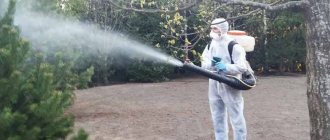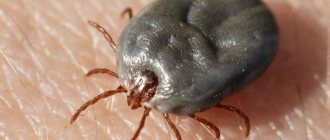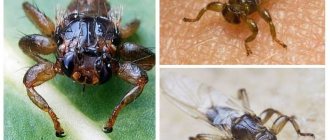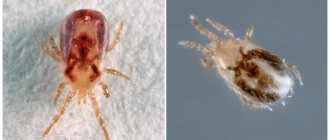Season starts in April
The Moscow region department of Rospotrebnadzor "RG" said that the number of victims of ticks increases sharply every year during the May holidays - here the seasonal activation of ticks and the mass exodus of people for picnics and summer cottages overlap each other.
Infectious disease experts say that ticks are moisture-loving, so they are most abundant near bodies of water and in shaded forests with thick grass. Many dangerous insects are also found in forest ravines, forest edges, and willow thickets on the banks of forest streams. That is, just where it is so convenient to lay out a blanket and have your first almost summer vacation in nature. “The results of observations from past years indicate that the tick-biting season in the Moscow region begins in the second ten days of April,” notes Rospotrebnadzor. — Their numbers increase rapidly, reaching a maximum by the beginning of the second ten days of May, and remain high until the middle or end of June, depending on the weather. Then it decreases sharply due to the extinction of ticks, whose reserve nutrients are depleted.”
What now, don’t go to nature and lock yourself in a city apartment until July? There is no need for such sacrifices - to protect yourself, it is enough to follow a few simple rules. The main ones are to tuck outerwear into pants, and pants into socks. It may not be fashionable, but it makes it much more difficult for ticks to reach open areas of the skin, and they don’t bite through clothing. In this case, you should avoid fabrics of dark shades, as it is more difficult to notice dangerous insects on them. You should not leave your head or neck uncovered - use a headdress, scarf or hood. Clothing should also be treated with a special aerosol - today you can buy them in almost any store or pharmacy. But you should approach the choice carefully - it is better to give preference to acaricidal or insecticidal-repellent agents. Simple repellent preparations, although less toxic and suitable for application to the skin, may still not cope with ticks.
Free vaccinations against viral tick-borne encephalitis can be done today in all Moscow clinics
“The products should be applied to clothing in ring strips, especially carefully treating areas around the ankles, knees, hips, waist, as well as at the sleeve cuffs and collar,” advise Rospotrebnadzor. “When using this or that product, be sure to read the instructions and follow their instructions.”
Periods of maximum tick activity
For those who are interested in when the tick season begins and ends, the answer is from April to October. With the onset of cold days, insects hibernate. They wake up in early spring. During the spring period when ticks are active, insects are the most aggressive, and therefore dangerous.
Having emerged from hibernation, they begin to intensively search for warm blood, without which it is difficult for them to wake up and begin to reproduce. Insects feed on the blood of both animals and humans.
A table of tick activity by month is presented below.
| Month | Activity | Note |
| April | 100% | Extremely aggressive. They bite hard and often because they are hungry |
| May | 98% | |
| June | 87% | |
| July | 75% | Moderately active |
| August | 85% | |
| September | 92% | Extremely aggressive. Eating before hibernation |
| October | 97-100% |
As can be seen from the table of tick activity by month in the Moscow region, insects show maximum aggression in those seasons when wet weather prevails. They feel great in shaded and moist deciduous and mixed forests. They thrive in thick grass and willow. Therefore, ticks in September and early spring are localized:
- in windbreaks;
- on the banks of rivers and the bottom of ravines;
- along forest paths overgrown with thick grass;
- on forest edges and parks.
But in fact, you can “catch” parasites anywhere during the periods when ticks are active - mid-April to mid-late October. Many contemporaries suggest that insects fall on them from the branches of trees and bushes. But this opinion is wrong. Hiding in the thickets, blood-sucking parasites literally rush at the victim who is nearby. They:
- from the first frost, when ticks cease to be active, they begin to actively hide in secluded places, preparing for hibernation;
- afraid of direct sunlight;
- love ambient temperatures up to 210C (forest cool);
- When the tick season begins, they bite very painfully, biting through a fairly large wound on the skin.
We have found out in what month and when exactly ticks are active, now we will find out how dangerous they are for animals and humans.
How dangerous are blood-sucking insects?
We have already found out that ticks are quite active in the Moscow region in September. Moreover, they are aggressive because they are preparing for hibernation. Their bites are unpleasant and dangerous for two reasons:
- Insects are carriers of viruses. Depending on the location of the parasite and its variety, it can cause infection of a healthy body with various viral infections - borreliosis, typhus and tick-borne relapsing fever, encephalitis, Crimean fever (hemorrhagic), babesiosis, spotted fever, etc. Answering the question, are they dangerous? ticks in the fall for humans, let's say yes.
- Insects can cause various diseases. It is quite difficult to remove a parasite that has been absorbed into the skin. Especially when a person starts to panic. In 7 out of 10 cases, the head remains in the wound, which becomes the cause of pustular lesions. Forest ticks in the fall are dangerous due to irritation and allergic reactions.
Young children and people with allergies can be significantly harmed by the bite of a single blood-sucking insect. The area of skin lesions can reach 1 cm or more.
Therefore, the question of whether ticks are dangerous in September in the Moscow region is as relevant as the question of the danger of insects in the spring-summer season. More often parasites transmit encephalitis. This is a very severe and fast-acting disease of viral etiology.
It affects the nervous system of a person or animal. The main complication of untimely treatment is irreversible changes in the brain. Therefore, you should be concerned not about whether there are ticks in September, but what they look like, how to get rid of them and protect yourself.
Let's look at these problems in more detail.
What does a blood-sucking parasite look like?
Having found out whether there are ticks in the Moscow region in September, we will learn to recognize the “enemy”. The insect has an arachnid appearance and a strongly flattened body 3-25 mm long and weighing 3-4 mg. The size of the body depends on the species. Moreover, females of all morphotypes are significantly larger than males.
During the active period of ticks, insects drink several times their body weight in blood. Their body spreads out in width, acquiring an ovoid shape. After feeding, the weight of the parasite can reach 40-500 mg. By the time tick season ends, the ticks look like the photo below.
Features of the body structure of the parasite:
- sharp trunk;
- organs of vision are absent. Instead, insects have well-developed receptors. During the active season of ticks, it is with their help that the blood-sucking parasite catches the smell of warm blood;
- four pairs of tenacious and mobile limbs;
- the claws on the feet have webbed suckers. During tick activity, the suckers help to stay on the victim's body;
- limbs consist of six segments;
- the respiratory plates are located at the back (behind the fourth pair of limbs);
- dorsal shield protecting the head.
Once again we will answer the question of whether there are ticks in the fall that suck blood and carry viral diseases. Yes, there are, and they are very active.
Therefore, experts recommend checking the skin for the presence of embedded parasites after every walk in the forest or in tall grass. The external characteristics of arthropod insects are described above.
The color of the cover ranges from light brown and brownish-red to black. After eating, the body color is dark gray. Remember: ticks are present in the fall and they are just as active and dangerous as in the spring.
Symptoms of encephalitis after a tick bite
An interesting fact is that only females suck blood. At the same time, they can increase in size by 100 times. Nature endowed them with a more protective cover and tenacity.
Bite without pain
Why are ticks dangerous? The insect bite itself is really not that scary, but the infections it can carry are dangerous. In addition, mites often dig into the skin so deeply that it becomes difficult to remove them. But you still need to remove the insect so as not to leave the proboscis in the skin.
You may not feel the bite itself, since the tick's saliva has an analgesic effect. At the same time, people usually receive the bulk of pathogens in the first minutes after suction.
The Moscow Department of Rospotrebnadzor says that ticks are the main carriers of tick-borne borreliosis, monocytic ehrlichiosis, granulocytic anaplasmosis and viral encephalitis. The latter is the most dangerous - this virus can lead to death. Fortunately, encephalitis ticks are extremely rare - last year, for example, almost 13.5 thousand people suffered from tick bites went to the capital's hospitals, but there were only 14 cases of encephalitis and all were imported, that is, infected ticks attacked person in another region or country.
The Moscow region as a whole is considered free from viral encephalitis, but there are exceptions in the region - these are the Dmitrovsky and Taldomsky districts, where the risk of infection is still high. And on the territory of Moscow itself this year there has not yet been a single case of ticks sucking on them - the city is not the most suitable environment for them, although there are many parks, squares and green ponds, etc. in the metropolis.
Therefore, the Moscow Department of Health also advises caution and reminds that you can get borreliosis even without a bite. For example, you are removing a tick from an animal or person and accidentally crush it in the process. If you rub your eyes, touch your nose, lips or damaged areas of skin with infected hands, you can also get sick. However, there is no vaccine against borreliosis. Over the three months of this year, 24 people in the Moscow region alone suffered from this disease, which is 1.6 times more than during the same period in 2021 - then 15 cases of infection were recorded.
Where and how can I get vaccinated against tick-borne viral encephalitis?
Several vaccines against tick-borne viral encephalitis are registered in the Russian Federation. Vaccination against tick-borne encephalitis can be done at vaccination points at clinics, medical units, and health centers of educational institutions after consulting a doctor.
It should be remembered that it is necessary to complete the entire vaccination course against tick-borne encephalitis 2 weeks before leaving for a disadvantaged area.
What to do and where to go if you are not vaccinated and were in a dangerous territory unfavorable for tick-borne encephalitis and a tick bite occurred?
Unvaccinated persons are given seroprophylaxis - the administration of human immunoglobulin against tick-borne encephalitis within 96 hours after biting ticks and contacting medical organizations according to indications.
Period of activity in the Moscow region
The period of ticks in Moscow begins at the end of April, beginning of May. The first to suffer from them are small rodents, wild hares, and dogs. It is during this period that breeders complain that they find ticks on the fur of their four-legged pets. If we talk about people, the first victims are summer residents and those who like to celebrate the May holidays in nature.
But since ticks love dry, moderately warm weather, at the height of summer their activity declines. In June and July they practically do not bother people. However, if the weather is favorable for them, the situation may change. But if the summer is really hot, then insects resume activity only at the end of August.
Ticks in the Moscow region 2021 symptoms, first aid for a bite: the beginning of the tick season
Ticks are most active in May and June, when the weather outside is warm, but not hot. After which, by mid-summer, tick activity begins to decline. However, towards the end of August the peak of tick bites begins again. The risk group includes summer residents and gardeners, since the tick season coincides with the period of summer cottage work.
In order to reduce the risk of being bitten by a tick in the country, you need to treat the area. In addition, each person needs to inspect the body after working at their summer cottage.
In the Moscow region, ticks can also be found in any park. They are treated against ticks, but it is still better to avoid walking away from asphalt paths, because this does not guarantee safety. In the summer, in order to protect yourself, it is best to use special products against such insects.











